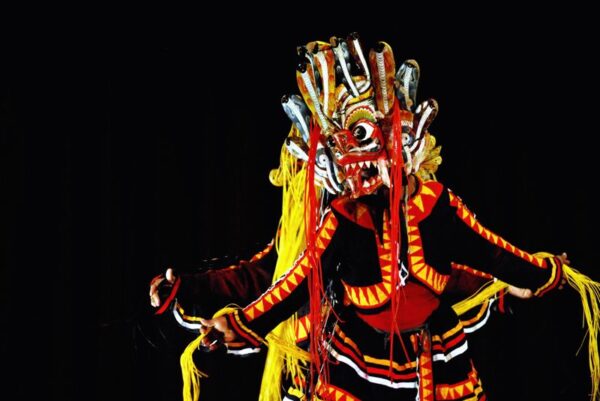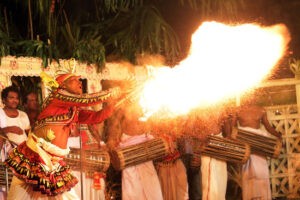Sri Lankan Healing Dance Rituals vs Psychotherapy – By Chalanka Athalage

Digging deeper into the Dance Rituals and practices in Sri Lanka, the writer intends to explore the healing capacity of dance rituals alongside western counselling psychology. Dance is one of the earliest forms of expression and communication, and the writer was intrigued to learn how it comes alive in many cultures worldwide as a healing ritual. This is evident in the first nation-people of Australia, the Māori communities of New Zealand, several African nations and many more countries across the globe. In Sri Lanka, Bali and Thovil are considered to be two incredibly powerful forms of healing dance rituals that have somehow survived the test of time and remain the most common forms of healing rituals even today. We found Bali and Thovil to be fascinating reflections of how humans inherently resort to dancing in search of solutions to their distress, phobias, and various other illnesses.

Healing, cure and therapy are the three interconnected notions, the most important parts of most known medical systems, whether it be western, ayurvedic, Hela Medicine, or any other method. The Merriam-Webster’s Medical Desk Dictionary defines therapy as remedial treatment of mental or bodily disorders. Traditional Sri Lankan healing rituals such as Bali and Thovil aim to restore harmony and balance within the individual through the interaction of the body, mind, and spirit. However, there is a growing trend in the Western cultures to seek alternative, complementary, and traditional healing not only as an alternative to biomedicine but also to psychotherapy and counselling. In M. S. Fernando’s book “Rituals, Folk Beliefs and Magical Arts of Sri Lanka” Dr N. D. Wijesekera argues that healing dance rituals or forms of ‘social magic’ are based on the belief that the world is full of visible and invisible forces, whose influence when mastered and controlled, can be directed in chosen ways to bring about wellbeing. Similarly, in Western Psychotherapy, through a series of counselling sessions, the practitioner, through therapy, supports the individual to reflect on their circumstances, helping them change their mindset, bringing happiness, confidence and mental harmony.
Therapeutic Intervention for Phobia
Phobia can be defined as an intense but irrational fear of something specific, usually an object, a situation, a person, or an experience. Having a phobia is not uncommon. Most of us may have experienced a phobia at some point in our lifetime. In western cultures, amongst many, psychotherapy is one of the more effective treatments for phobias. This involves working with a specially trained therapist to re-evaluate your beliefs about the feared object or situation to manage the response. However, some indigenous cultures may have a different approach to psychotherapy. Such practices are evident in Sri Lanka and other cultures across the globe. Dance, the sound of the drum, and the ritualistic practices replace the methodology used in psychotherapy and the Ritual Master. Sometimes the dancer himself takes the role of the therapist. However, both techniques have one common goal: to get rid of the phobia itself or the fear, bringing mental peace, harmony, and calmness. In western practices, one of the approaches therapists uses is Exposure Therapy. Exposure therapy is a way of gradually bringing you closer to something you fear. It usually begins by getting the person to reflect on the feared object, followed by exposing the person to various things associated with the fear, such as photographs, videos, music etc. As the person approaches each one, the therapist guides the person using relaxation skills to calm the associated anxiety. Many similar practices occur in Sri Lankan Dance rituals, such as Bali and Thovil.
The Ritual Masters wear elaborately carved wooden masks to represent spirits, demons and deities, essentially supernatural embodiments of diseases, planets, and other forces of nature that people constantly struggle against, and gradually remove the fear and phobia. The stage, dance arena, Yahana or the temporary altar and the dance costumes are mainly made of natural material, such as fibre, flowers, and leaves, bringing everyone present closer to nature. This closeness and connection to nature brings positive emotions to those present and mainly to the person or people who expect blessings and healing.
In conclusion, both Sri Lankan Dance Rituals Bali, Thovil and Western Psychotherapy reinforces the importance of a holistic approach in treating the root cause of the problem and bringing mental peace, harmony and healing to the people who seek intervention. A combination of the dance ritual, music, stanzas, the sound of drums, the environment, the costumes, and masks, act as the medium, connecting the human world with the supernatural world. Similar results are also achieved through therapy used in western psychotherapy practices. Both practices significantly contribute to the patient’s mood and restore their psychophysical balance. Western medical treatment is more effective when the patient is in good mental health. Hence no one can discount the value and effectiveness of these dance rituals.
By Chalanka Athalage
Thaala Asapuwa Sri Lankan Dance Academy of Victoria, Australia







